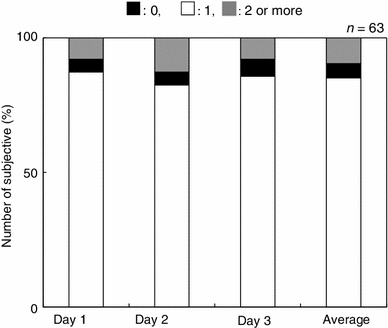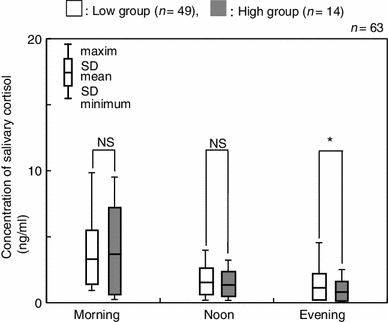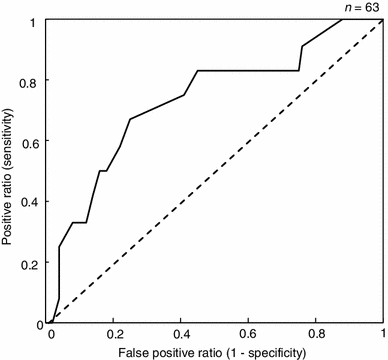Relationship between salivary cortisol and depression in adolescent survivors of a major natural disaster
- PMID: 24744089
- PMCID: PMC4070489
- DOI: 10.1007/s12576-014-0315-x
Relationship between salivary cortisol and depression in adolescent survivors of a major natural disaster
Abstract
The purpose of this study was to determine the utility of salivary cortisol levels for screening mental states such as depression in adolescents following a natural disaster. We examined the relationship of salivary cortisol levels in adolescent survivors of the 2011 Tohoku Earthquake with the depression subscale of the 28-item General Health Questionnaire (GHQ). Subjects were 63 adolescent survivors (age = 14.29 years ± 0.51) who were administered the GHQ and provided saliva samples thrice daily (morning, afternoon and evening) over the course of 3 days. Based on the GHQ-depression subscores, subjects were divided into low and high depression groups. About 22 % of the subjects were classified into the high symptom group. When data collected over 3 days were used, a significant difference was observed between the two groups in the salivary cortisol levels at the evening time point as well the ratio of the morning/evening levels (p < 0.05). Analyzed by means of receiver-operating characteristic curves, the morning/evening ratios showed a good power in discriminating between subjects with and without depressive symptoms. Our study suggests that repeated measurement of salivary cortisol levels over 3 days has utility in screening for depressive states in adolescents following a natural disaster.
Conflict of interest statement
The authors declare they have no conflicts of interest.
Figures








Similar articles
-
Salivary cortisol and depression in public sector employees: cross-sectional and short term follow-up findings.Psychoneuroendocrinology. 2014 Mar;41:63-74. doi: 10.1016/j.psyneuen.2013.12.006. Epub 2013 Dec 16. Psychoneuroendocrinology. 2014. PMID: 24495608
-
A two-year follow-up study of salivary cortisol concentration and the risk of depression.Psychoneuroendocrinology. 2013 Oct;38(10):2042-50. doi: 10.1016/j.psyneuen.2013.03.013. Epub 2013 Apr 15. Psychoneuroendocrinology. 2013. PMID: 23597874
-
Salivary Aldosterone, Cortisol, and Their Morning to Evening Slopes in Patients with Depressive Disorder and Healthy Subjects: Acute Episode and Follow-Up 6 Months after Reaching Remission.Neuroendocrinology. 2020;110(11-12):1001-1009. doi: 10.1159/000505921. Epub 2020 Jan 15. Neuroendocrinology. 2020. PMID: 31935730
-
Effects of the Higashi-Nihon earthquake: posttraumatic stress, psychological changes, and cortisol levels of survivors.PLoS One. 2012;7(4):e34612. doi: 10.1371/journal.pone.0034612. Epub 2012 Apr 25. PLoS One. 2012. PMID: 22558092 Free PMC article.
-
The self-perceived symptom distress and health-related conditions associated with morning to evening diurnal cortisol patterns in outpatients with major depressive disorder.Psychoneuroendocrinology. 2010 May;35(4):503-15. doi: 10.1016/j.psyneuen.2009.08.019. Epub 2009 Sep 22. Psychoneuroendocrinology. 2010. PMID: 19775819
Cited by
-
Salivary mental stress biomarkers in COVID-19 patients.Front Med (Lausanne). 2022 Nov 2;9:999215. doi: 10.3389/fmed.2022.999215. eCollection 2022. Front Med (Lausanne). 2022. PMID: 36405600 Free PMC article.
-
Periodontal and peri-implant status and whole salivary interleukin 1-beta levels among individuals using selective serotonin reuptake inhibitors: an observational study.BMC Oral Health. 2023 May 22;23(1):310. doi: 10.1186/s12903-023-02908-0. BMC Oral Health. 2023. PMID: 37217913 Free PMC article.
-
Salivary Biomarkers of Stress, Anxiety and Depression.J Clin Med. 2021 Feb 1;10(3):517. doi: 10.3390/jcm10030517. J Clin Med. 2021. PMID: 33535653 Free PMC article. Review.
-
Individualized identification value of stress-related network structural-functional properties and HPA axis reactivity for subthreshold depression.Transl Psychiatry. 2024 Dec 23;14(1):501. doi: 10.1038/s41398-024-03210-5. Transl Psychiatry. 2024. PMID: 39715743 Free PMC article.
-
Depression in Youth Exposed to Disasters, Terrorism and Political Violence.Curr Psychiatry Rep. 2019 Jul 4;21(8):73. doi: 10.1007/s11920-019-1061-9. Curr Psychiatry Rep. 2019. PMID: 31270638 Review.
References
-
- Mimura N, Yasuhara K, Kawagoe S, Yokoki H, Kazama S. Damage from the great East Japan earthquake and tsunami—a quick report. Mitig Adapt Strateg Glob Change. 2011
-
- Hayashi K, Tomita N. Lessons learned from the great East Japan earthquake impact on child and adolescent health. Asia Pac J Public Health. 2012 - PubMed
-
- Connor KM, Foa EB, Davidson JRT. Practical assessment and evaluation of mental health problems following a mass disaster. J Clin Psychiatry. 2006;67:26–33. - PubMed
-
- Goenjian AK, Pynoos RS, Steinberg AM, Najarian LM, Asarnow JR, Karayan I, Ghurabi M, Fairbanks LA. Psychiatric comorbidity in children after the 1988: earthquake in Armenia. J Am Acad Child Adolesc Psychiatry. 1995 - PubMed
Publication types
MeSH terms
Substances
Grants and funding
LinkOut - more resources
Full Text Sources
Other Literature Sources
Medical

